Rupert Matthews's Blog, page 38
July 17, 2012
NEW BOOK - The Battle of Pulu Aor (1804)

A key naval action that confirmed British control of the Indian Ocean
and its rich trade at a crucial point in the Napoleonic Wars.
The
battle of Pulo Aor is today rather overshadowed by the contemporary
victories of Nelson in European waters, but in its day it was every bit
as famous as Trafalgar, Aboukir and The Saints.
In 1803 French
Emperor Napoleon sent Admiral Charles-Alexander Linois with a powerful
fleet of warships to the Indian Ocean to disrupt the rich Eastern trade
on which Britain relied to finance its war effort against France. After
preliminary skirmishing and manoeuvres, Linois closed with the main
British merchant convoy of the winter off the island of Pulo Aor.
The
British commander, Commodore Nathaniel Dance knew he was heavily
outnumbered, but he gambled on Linois’s caution and an bold display of
aggression to make up for his lack of numbers. In the battle that
followed the French ships were driven off as much by clever use of the
wind and swift manoeuvring as by gunfire. Dance went home to a hero’s
welcome, leaving Linois to lick his wounds and prepare for a final
showdown with the British navy some months later.
About the Author
Rupert
Matthews has written over 150 books for different publishers, achieving
significant sales in a variety of markets both in the UK and abroad.
His works have been translated into 19 languages and have been
shortlisted for a number of awards. Rupert has been a freelance writer
for 20 years, working in-house at a major book publisher before going
freelance.
Buy your Kindle version HERE
Buy other ebook formats HERE

Published on July 17, 2012 01:42
July 16, 2012
The railway comes to Wallingford, Berks
South of Abingdon lies the last of the lost railways of Berkshire, the short branchline that ran to Wallingford. The good citizens of Wallingford had been railway enthusiasts from the moment the GWR was first proposed. They were deeply disappointed when the mainline passed three miles west of their town and were particularly annoyed when the station built to serve their town was named Moulsford, after the village in which it stood. Within six months protests from the town got the station’s name changed to Wallingford Road.
This was not enough for the people of Wallingford. When the GWR definitively refused to build a branch line, the town decided to build one for itself. In 1864 the Wallingford and Watlington Railway Company gained an Act of Parliament authorising it to build a line from the GWR mainline near Cholsey to Watlington. The company opted to build on the standard gauge, so the line could not share rolling stock with broad gauge GWR. Instead the branch line had a bay platform at the old Wallingford Road station, now renamed Moulsford once again.
The Wallingford and Watlington Railway Company was able to raise only enough money to build the line from Cholsey as far as Wallingford. The cost of bridging the Thames proved to be beyond the abilities of the brokers to sell shares, so Watlington remained without its railway. Nevertheless, the company directors were jubilant as they rode the first train from Moulsford to Wallingford on 2 July 1866.
from LOST RAILWAYS OF BERKSHIRE
Buy your copy HERE
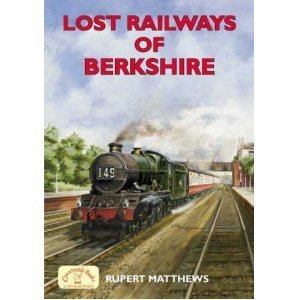


This was not enough for the people of Wallingford. When the GWR definitively refused to build a branch line, the town decided to build one for itself. In 1864 the Wallingford and Watlington Railway Company gained an Act of Parliament authorising it to build a line from the GWR mainline near Cholsey to Watlington. The company opted to build on the standard gauge, so the line could not share rolling stock with broad gauge GWR. Instead the branch line had a bay platform at the old Wallingford Road station, now renamed Moulsford once again.
The Wallingford and Watlington Railway Company was able to raise only enough money to build the line from Cholsey as far as Wallingford. The cost of bridging the Thames proved to be beyond the abilities of the brokers to sell shares, so Watlington remained without its railway. Nevertheless, the company directors were jubilant as they rode the first train from Moulsford to Wallingford on 2 July 1866.
from LOST RAILWAYS OF BERKSHIRE
Buy your copy HERE


Published on July 16, 2012 01:29
July 13, 2012
Richmond Palace, Surrey

A view of Richmond Palace as it appeared in about 1630.
from "A Little Book of Surrey" by Rupert Matthews.
By your copy HERE
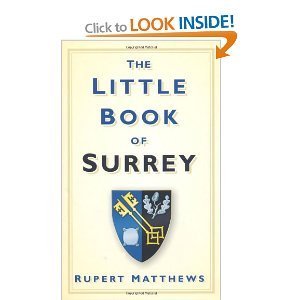 The Little Book of Surrey is a funny, fast-paced,
The Little Book of Surrey is a funny, fast-paced, fact-packed compendium of the sort of frivolous, fantastic or simply
strange information which no-one will want to be without. The county's
most unusual crimes and punishments, eccentric inhabitants, famous sons
and daughters, royal connections and literally hundreds of wacky facts
about Surrey's landscape, towns and villages (plus some authentically
bizarre bits of historic trivia), come together to make it essential
reading for visitors and locals alike.

Published on July 13, 2012 01:21
July 10, 2012
Leicester Cuisine
The great city of Leicester sits at the heart of the county, the centre occupying the same site it has done since the Romans built their city of Ratae Corieltauvorum here in ad50 on the site of an earlier Celtic town. The city formed the administrative centre for the county and adjacent areas in Roman times, and has dominated the economy of that same stretch of countryside ever since. In 1937 the League of Nations produced a report that named Leicester as the best city to live in to be found in the British Empire. Though the Empire has gone, the city remains an attractive place that has boomed in population as more and more people have moved to live here. What were once separate villages such as Knighton, Aylestone and Oadby have been brought into the city as suburbs.
The growing populations of the towns and city have provided a ready market for the foods and drinks produced by the rural areas. This has encouraged the production of numerous delicacies and staples on a scale that would have been impossible without the urban demand. And the towns and cities have produced impressive products of their own. Most breweries have been, and still are, located in the towns, while bakeries and other processing units have turned out some great foods.
In recent decades the influx of people with cultural roots in the Indian subcontinent has brought an entirely new culinary tradition to the county. Today the Asian community in Leicester turns out a wide range of craft foods that can match in quality and variety the more traditionally English heritage of the county.
from FOOD AND DRINK IN LEICESTERSHIRE by Rupert Matthews.
Buy Your Copy HERE


Published on July 10, 2012 08:12
July 5, 2012
Hitler turns east against Russia
[image error]
As early as the 1920s, Hitler had openly declared that the destruction of Soviet Bolshevism was his ultimate and over-riding aim. The breaking of the Russian Empire would also open up vast tracts of land in the east for German expansion, known as lebensraum or ‘living space’. With Operation Barbarossa, Hitler was to make his attempt to put this ambition into practice. His plans were meticulous, clever and stood a fair chance of success. In the event it was Hitler himself who was to undermine them and cause ultimate defeat.
By the late summer of 1940 Hitler had decided to launch an attack on Russia in 1941. It is likely that he had always planned to mount a rolling war of successive campaigns. First Poland was to be crushed in the east, then Britain and France were to be defeated in west, then he could turn east again to take on Russia. Driving this strategy was the traditional, and very rational, fear of a war on two fronts. If Hitler was to be certain of success he would need to concentrate the entire armed might of the Wehrmacht against one opponent at a time.
This guiding strategy started to go wrong when Britain did not, as Hitler had expected, make peace after the fall of France. The continuing defiance of Britain meant that the Kriegsmarine, the navy, needed to be sent into the North Atlantic to attack convoys and the Luftwaffe had to keep forces in France to launch bombing raids on Britain. More seriously, the lack of a western peace forced Hitler to keep army units in France, Belgium, Holland, Denmark and Norway to prevent a British invasion. These were, on the whole, reserve units rather than the elite of the army, but they were nevertheless tied down in the West and were unavailable for the war in the East.
In July 1940 Hitler held a meeting with his senior commanders. He gave a sweeping overview of the strategic situation, then came to a surprising conclusion. “Britain’s hope lies with Russia and the United States. If Russia drops out of the picture, America is also lost to Britain because the elimination of Russia would free Japan in the Far East. My decision is that Russia’s destruction must be made a part of this struggle. The sooner Russia is crushed the better. If we start in May 1941 we will have five months to finish the job.”
In one sense, Hitler’s strategic conclusions were correct. Germany had the vast majority of her armed might in the army, not in the Kriegsmarine or the Luftwaffe. Britain could not be invaded or defeated by the army, so it would be best to use this superb fighting machine elsewhere. The defeat of Russia would, as Hitler argued, totally change the world situation and might very well have brought peace with Britain. But Hitler had not, at this point, undertaken a practical review of what was involved in defeating Russia. The question was, could Russia be beaten?
from HITLER MILITARY COMMANDER by Rupert Matthews
Buy your copy HERE


Published on July 05, 2012 02:00
July 3, 2012
The Greatest Buccaneer of them all - Sir Harry Morgan
[image error]
Henry Morgan was the most successful buccaneer of all. He was born in South Wales in about 1635 and by 1662 was the captain of a buccaneer ship sailing from Port Royal. His greatest exploit was to recruit an army of 2,000 buccaneers and 33 ships with which he captured the city of Panama in 1671. Panama was the richest Spanish city in America at the time. In 1675 Morgan retired from the sea and invested his loot so that he had plenty of
money to live on.
Morgan and his buccaneers fight their way into the city of Panama. Morgan captured several cities and dozens of ships. He would threaten to burn the cities down unless the Spanish paid him huge sums of money.
You Must Be Joking
On every voyage Morgan managed to sink his own ship on rocks or in a storm. However, he was so successful as a buccaneer that he always managed to steal several more before returning home.
Can You Believe It?
Henry Morgan was knighted by King Charles II.
YES. In 1672 Morgan went to England. He so impressed King Charles II with his exploits that the king not only knighted Morgan, but also made him Deputy Governor of Jamaica.

Published on July 03, 2012 01:06
June 29, 2012
A Difficult Commanding Officer
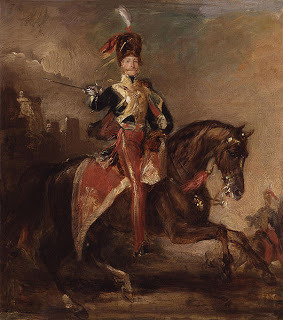
James Brudenell, 7th Earl of Cardigan, (1797-1868) earned great fame as the man who led the heroic, but futile Charge of the Light Brigade at the Battle of Balaclava in 1854. He insisted on aristocratic manners and once courtmartialled an officer for ordering beer, instead of wine, at dinner. He challenged another to a duel for turning up for dinner with improperly polished buttons. Undoubtedly brave, his prickly temperament and unpopularity with more senior officers led to his retirement in 1866.
from Heroes, Rogues and Rascals by Rupert Matthews.
Buy your copy HERE


Published on June 29, 2012 01:13
June 27, 2012
Goering holds a strategy meeting August 1940
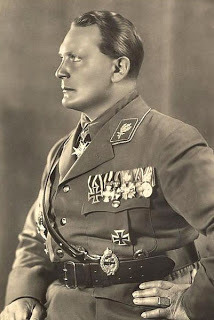
Towards the end of August 1940 Goering held another top level conference of Luftwaffe commanders. The senior officers pored over the combat reports, intelligence analyses and other documents before discussing how best to complete the destruction of RAF Fighter Command in southeastern England. The results of that conference proved to be disastrous for Britain and came very close to handing victory to the Luftwaffe in what was now being seen by both sides as The Battle of Britain.
The first fact acknowledged by the Luftwaffe high command was that their intelligence reports were faulty. The strength of Fighter Command in terms of modern fighters had been badly underestimated, so that no matter how many Hurricanes and Spitfires were shot down there were still plenty more coming up to replace them. In fact the intelligence reports had not been so far of the mark as the Germans supposed. They had estimated fairly accurately the strength of Fighter Command, but had got wrong the speed with which Britain could turn out new fighters.
Goering, as a highly experienced fighter pilot from the First World War, would have known that in the hectic swirl of war flying it is quite easy for fighter pilots to claim to have shot down more enemy aircraft than in fact they had. Even when being completely honest, a fighter pilot might claim as destroyed an enemy aircraft that was in fact badly damaged and managed to limp home. Or two pilots might claim the same victim as they both fired at it as it went down. What was almost impossible to know was the ratio at which the overclaiming occurred. After the war historians compared the records of both sides and found that the British had been overclaiming by about 1.7 to 1 (the ratio was later to rise) at this period while the Germans overclaimed by about 2 to 1.
If the actual aircraft were not being destroyed as fast as hoped, neither were the airfields. The efficiency of repair crews meant that the RAF could get fighter bases back into operation much faster than the Germans thought possible. After a heavy bombing raid the Luftwaffe marked an airbase as destroyed, and estimated it would take at least two weeks to get it working again. In fact most Fighter Command airfields were back in at least partial operation within a day or two.
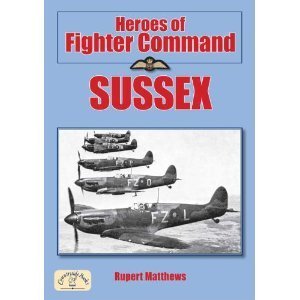
from Heroes of Fighter Command Sussex by Rupert Matthews
Buy your copy here

Published on June 27, 2012 02:37
June 25, 2012
RAF Fighter Command goes to the "Circus"

After the change of higher command within Fighter Command towards the end of 1940 there was a rethinking of strategy. It was now clear that any German invasion of Britain could not take place until the good weather of spring arrived again in April or May 1941. The head of Fighter Command, Sholto Douglas, was confident that with the increasing numbers of pilots and aircraft arriving under his command over the winter he would be able to stop the Germans gaining control of the air. Nevertheless a good deal of planning and preparation went on so that Fighter Command would be ready for the fray when it came.
Meanwhile, Douglas had to keep his men busy over the winter. He was as determined to keep his own men in training and ready for action as he was to probe continually and test the strength of the Luftwaffe across the Channel.
The attack on Le Touquet airfield by two Spitfires in December had shown the way forward. These low-level, high-speed missions by two or three fighters were dubbed “Rhubarbs”. A similar mission but carried out with an entire squadron was designated a “Rodeo”. While Rhubarbs could be suggested by squadrons and approved by Group HQ, Rodeos had to be authorised and planned by Fighter Command HQ. “Jim Crows” were regular patrols that were carried out day after day along set routes to search for enemy activity. Most of them took place over the Channel.
Rather more formal, in that they had a definite objective, were “Ramrods”. These were bombing missions undertaken by the squadrons of RAF Bomber Command to which Fighter Command was expected to provide fighter cover. Most such missions had one force of fighters providing cover to the bombers on the way out, with a second force taking off later to escort them back when the first group of fighters began to run low on fuel.
Altogether different were the “Circus” missions. These were designed to appear to the Germans as if they were a normal Ramrod, but in fact were structured so that it was Fighter Command that took the lead. The bombers were present only in small numbers and were there simply to give the illusion of a bombing mission. In fact the half a dozen or so bombers were escorted by as many as fifty or more fighters. The aim was to lure the German fighters up to attack the bombers, then for the British fighters to pounce on them in overwhelming numbers.

Published on June 25, 2012 07:02
June 21, 2012
Barnes Wallis first thinks about destroying dams
The chain of events that led up to the famous Dambusters Raid began the day before war was declared. Aircraft designer Barnes Wallis, who had designed the Wellington bomber for Vickers, decided to search for a way in which bombers could cripple Germany’s industrial might and so shorten the war. He quickly came to the conclusion that this could best be achieved by destroying either the sources of power or the means of transport. He turned to power first.
The Romanian oilfields were too distant for bombers to reach from Britain and coal mines were too deep underground to be affected by bombs. That left dams. Germany was fortunate in having mountainous regions close to her industrial centres. These mountains had high rainfall and deep valleys, which made them ideal for building dams. These dams provided hydro-electric power, but they also stored the vast quantities of water needed by 1940s heavy industry. And they were often used as reservoirs for the canal system as well. Destroy a dam, reasoned Wallis, and you could badly hit power, industry and transport in one go.
There were three dams that stood out as being key to Germany’s industry, all of them in the range of hills between the Rhine and Ruhr rivers. The Moehne Dam held 134 million tons of water. The Eder held 212 million tons of water and also fed water into the Mittelland Canal, Germany’s busiest industrial waterway. The Sorpe held around 180 million tons of water and fed drinking water to the surrounding cities. Together the three provided getting on for half the electric power of the vast Ruhr industrial metropolis.
That the destruction of the dams would be a huge blow to Germany, nobody could doubt. The question was how to go about destroying them.

from HEROES OF THE RAF BOMBER COMMAND, LINCOLNSHIRE by Rupert Matthews.
Buy your copy HERE

The Romanian oilfields were too distant for bombers to reach from Britain and coal mines were too deep underground to be affected by bombs. That left dams. Germany was fortunate in having mountainous regions close to her industrial centres. These mountains had high rainfall and deep valleys, which made them ideal for building dams. These dams provided hydro-electric power, but they also stored the vast quantities of water needed by 1940s heavy industry. And they were often used as reservoirs for the canal system as well. Destroy a dam, reasoned Wallis, and you could badly hit power, industry and transport in one go.
There were three dams that stood out as being key to Germany’s industry, all of them in the range of hills between the Rhine and Ruhr rivers. The Moehne Dam held 134 million tons of water. The Eder held 212 million tons of water and also fed water into the Mittelland Canal, Germany’s busiest industrial waterway. The Sorpe held around 180 million tons of water and fed drinking water to the surrounding cities. Together the three provided getting on for half the electric power of the vast Ruhr industrial metropolis.
That the destruction of the dams would be a huge blow to Germany, nobody could doubt. The question was how to go about destroying them.

from HEROES OF THE RAF BOMBER COMMAND, LINCOLNSHIRE by Rupert Matthews.
Buy your copy HERE

Published on June 21, 2012 01:42























